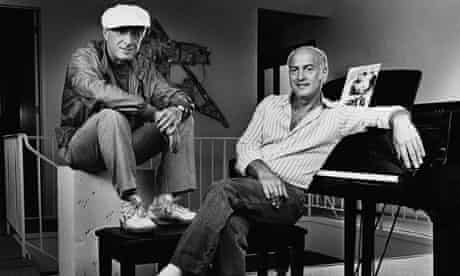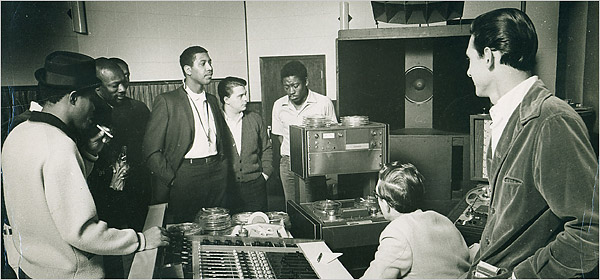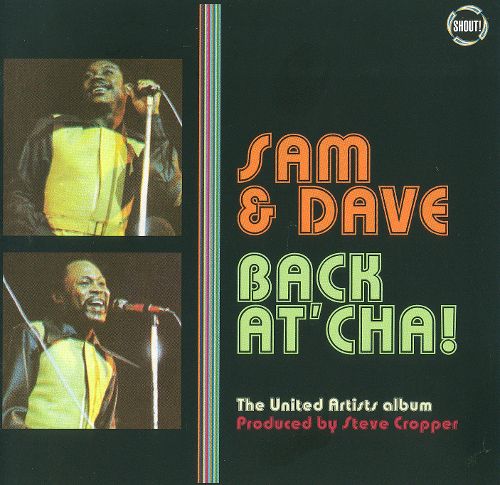I believe Jerry Leiber and Mike Stoller first entered my radar screen as a 13-year-old when I got an Elvis Presley songbook for guitar. It was shortly after I had started taking lessons and was able to play a few chords. Elvis was my idol at the time. What I didn’t know then and frankly didn’t fully appreciate until conducting some research for this post was the enormous scope of Leiber-Stoller’s work, which goes far beyond some of the best-known early classic rock & roll tunes.
For some time, I had contemplated writing about important songwriting partnerships including Leiber-Stoller, but once I noticed how many songs these guys wrote and how many artists they worked with, I felt they warranted a dedicated post. I also decided to largely exclude their production work and primarily focus on their writing during the ’50s and early ’60s, which is their most exciting period, in my opinion.
Lyricist Jerry Leiber was born as Jerome Leiber on April 25, 1933 in Baltimore, Md. Composer Michael Stoller, who later changed his legal fist name to Mike, was born on March 13, 1933 in Belle Harbor, Queens, N.Y. In addition to being born the same year to Jewish families, Leiber and Stoller also shared a love for blues, boogie-woogie and black culture. They met in Los Angeles in 1950, while Leiber was a senior in high school and Stoller was a college freshman.

According to an extended interview Lieber and Stoller gave to NAMM Oral History Program in December 2007, Leiber had written some lyrics and knew he wanted to be a songwriter. What he didn’t know was how to write music. A drummer referred him to piano player Mike Stoller. Once they met and Stoller looked at some of Leiber’s lyrics, he noticed they were 12-bar blues. He said, “I love the blues” and started playing the piano, with Leiber singing along. And Stoller said, “Mike, I think this is the beginning of a beautiful friendship.” Okay, I made up that last quote, borrowing from one of my favorite black and white movies of all time. What is true is that day the two men agreed to form a partnership that would generate some of the best-known songs of the ’50s and ’60s.
The first artist who recorded a Leiber-Stoller composition was Jimmy Witherspoon, one of the blues singers the duo followed to help them develop their “black style” of writing music and lyrics. Real Ugly Woman appeared as a single in 1951. The words are just as lovely as the title! 🙂 A little excerpt: Well, she’s a real ugly woman/Don’t see how she got that way/Yeah, she’s a real ugly woman/Don’t see how she got that way/Yes, and every time she comes around/she runs all my friends away…
The following year in 1952, Leiber and Stoller scored their first hit with Hard Times, which was recorded by Charles Brown. The tune climbed to no. 7 on the Billboard R&B Chart.
1952 also saw one of Leiber and Stoller’s best-known songs, Hound Dog, which was first recorded by Big Mama Thornton. It was also the first time the duo produced music, though the production credits went to Johnny Otis, who was supposed to lead the recording session but ended up playing the drums on the tune. Released in February that year, it sold more than half a million copies and topped the Billboard R&B Chart. Three years later, Elvis Presley turned Hound Dog into a mega-hit. I like his version but have to say Thornton really killed it, so here’s her original.
Another early rock & roll classic penned by Lieber-Stoller is Kansas City, which according to Wikipedia is one of their most recorded tunes with over three hundred versions – they had to count them all! Initially, the tune was titled K.C. Loving and recorded by American boogie-woogie pianist and singer Little Willie Littlefield. It appeared in August 1952. While the song had some regional success, it didn’t chart nationally. That changed in April 1959 when Wilbert Harrison released his version, which became a no. 1 on the Billboard’s Hot 100 and R&B charts. Here’s the original. Feel free to shuffle along!
Going back to Elvis, while Leiber and Stoller didn’t mind having written a million-seller with Hound Dog, they weren’t particularly fond of Presley’s cover. But it led to writing more songs for Elvis, including one of my favorite ’50s rock & roll tunes of all time: Jailhouse Rock. Released in September 1957, is was the title track of the Elvis motion picture that came out in November of the same year. Leiber-Stoller played a prominent role in the making of the film’s soundtrack. Apart from Jailhouse Rock, they wrote three other tunes and worked with Elvis in the studio. Of course, I had to take a clip from the picture, which has to be one of the most iconic dance scenes ever captured on film. Doesn’t it feel a bit like watching an early version of a Michael Jackson music video?
Blues and rock & roll represent the early years of Leiber and Stoller’s songwriting. Beginning in the mid-’50s after they had started working for Atlantic Records, the duo branched out and became more pop-oriented. Among other artists, they wrote a number of songs for The Drifters and The Coasters. Here’s Ruby Baby, a great soulful, groovy, doo-wop tune from 1956. More than 25 years later, Donald Fagen became one of the other artists covering the song, when he included it on his excellent debut solo album The Nightfly from October 1982.
Next up: Yakety Yak by The Coasters. The song was released in April 1958 and topped the Billboard Pop Chart, Billboard R&B Chart and Cash Box Pop Chart. The track was also produced by Leiber-Stoller and became the biggest hit for The Coasters.
The last Leiber-Stoller tune I’d like to highlight is Stand By Me, which they co-wrote with Ben E. King. He first recorded it in April 1961, a year after he had left The Drifters to start a solo career. In addition to writing, once again Leiber-Stoller also produced the beautiful track, which remains one of my favorite ’60s songs to this day.
Asked during the above NAMM interview to comment on the fact that “nice Jewish boys didn’t really write a whole lot of hit records for blues singers at that point” (in the early ’50s), Stoller said, “Actually, they did later on, or at least later on we did know…It was considered to be somewhat peculiar at the time.” Added Lieber: “Black people always thought we were black until they came in contact with us and saw that we weren’t.” BTW, if you’re into rock & roll history, you may enjoy watching the entire interview, even though it’s close to 90 minutes. Again, you can do so here.
Altogether, Jerry Leiber and Mike Stoller wrote or co-wrote 70-plus chart hits. According to lieberstoller.com, their songs have been performed by more than 1,000 artists, who in addition to the above include The Beatles, The Rolling Stones, B.B. King, James Brown, Little Richard, Jerry Lee Lewis, The Beach Boys, Buddy Holly, Fats Domino, Frank Sinatra, Barbra Streisand, Jimi Hendrix, Muddy Waters, Joe Williams, Tom Jones, Count Basie, Eric Clapton, Willie Nelson, Luther Vandross, John Lennon, Aretha Franklin and even Edith Piaf, among others – wow, it almost poses the question which artists did not sing their songs!
Leiber-Stoller’s work has extensively and rightly been recognized. Accolades include inductions into the Rock and Roll Hall of Fame and Songwriters Hall of Fame in 1987 and 1985, respectively, as well as a Lifetime Achievement Award by the National Academy of Songwriters in 1996. As reported by The New York Times, Jerry Leiber died from cardio-pulmonary failure on August 22, 2011 in Los Angeles at the age of 78. Mike Stoller is 86 years old and still alive. He can be heard introducing Little Steven & The Disciples of Soul on their great 2018 Soulfire Live! album for a gig at the Orpheum Theatre in New York – priceless!
Sources: Wikipedia; NAMM; Leiberstoller.com; The New York Times; YouTube





















